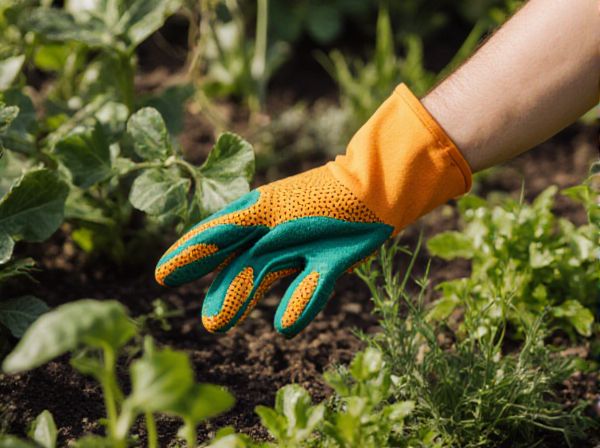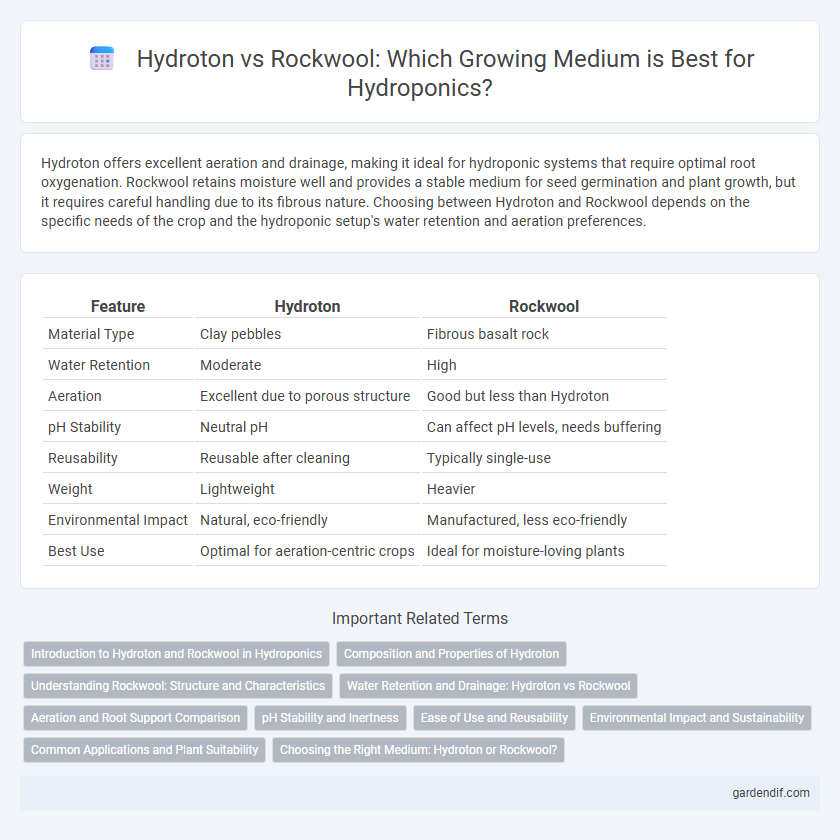
Hydroton vs Rockwool Illustration
Hydroton offers excellent aeration and drainage, making it ideal for hydroponic systems that require optimal root oxygenation. Rockwool retains moisture well and provides a stable medium for seed germination and plant growth, but it requires careful handling due to its fibrous nature. Choosing between Hydroton and Rockwool depends on the specific needs of the crop and the hydroponic setup's water retention and aeration preferences.
Table of Comparison
| Feature | Hydroton | Rockwool |
|---|---|---|
| Material Type | Clay pebbles | Fibrous basalt rock |
| Water Retention | Moderate | High |
| Aeration | Excellent due to porous structure | Good but less than Hydroton |
| pH Stability | Neutral pH | Can affect pH levels, needs buffering |
| Reusability | Reusable after cleaning | Typically single-use |
| Weight | Lightweight | Heavier |
| Environmental Impact | Natural, eco-friendly | Manufactured, less eco-friendly |
| Best Use | Optimal for aeration-centric crops | Ideal for moisture-loving plants |
Introduction to Hydroton and Rockwool in Hydroponics
Hydroton, also known as expanded clay pellets, provides excellent aeration and drainage for hydroponic systems, promoting strong root development and preventing waterlogging. Rockwool, derived from spun volcanic rock, offers high water retention and stable pH levels, making it ideal for seed germination and young plant growth. Both media are widely used in hydroponics due to their inert nature and ability to support efficient nutrient delivery to plants.
Composition and Properties of Hydroton
Hydroton is composed of expanded clay pellets, characterized by their lightweight and porous structure, which provides excellent aeration and drainage for plant roots. These pellets retain moisture while preventing waterlogging, promoting healthy root development and reducing the risk of root rot. Unlike Rockwool, which is made from spun basalt rock fibers, Hydroton offers a more reusable and environmentally friendly option in hydroponic growing media.
Understanding Rockwool: Structure and Characteristics
Rockwool, a popular hydroponic growing medium, consists of spun volcanic rock fibers that create a porous and absorbent structure ideal for root aeration and water retention. Its fibrous texture provides excellent support and maintains an optimal balance of moisture and oxygen around plant roots. Unlike Hydroton, Rockwool does not degrade over time but requires careful handling to prevent respiratory irritation due to its fine fibers.
Water Retention and Drainage: Hydroton vs Rockwool
Hydroton offers excellent drainage due to its porous clay pellets, preventing waterlogging while maintaining moderate water retention suitable for various hydroponic systems. Rockwool provides superior water retention by absorbing and holding moisture effectively, ensuring consistent hydration but can retain excess water if not managed properly. Choosing between Hydroton and Rockwool depends on balancing water retention needs with drainage efficiency for specific plant types and growth stages.
Aeration and Root Support Comparison
Hydroton provides superior aeration due to its porous clay pellets that allow optimal oxygen flow, preventing root suffocation and promoting healthy root growth. Rockwool offers consistent root support with its fibrous texture but can retain excess moisture, risking root rot if not properly managed. The choice between Hydroton and Rockwool depends on balancing aeration needs and stability for the plant's root system in hydroponic setups.
pH Stability and Inertness
Hydroton offers superior pH stability due to its inert nature, preventing fluctuations that can stress plant roots. Rockwool tends to alter pH levels because it is slightly alkaline, requiring careful monitoring and adjustment in hydroponic systems. The inertness of Hydroton ensures a consistent growing medium, making it ideal for maintaining optimal nutrient uptake and preventing nutrient lockout.
Ease of Use and Reusability
Hydroton provides superior ease of use with its lightweight, pH-neutral clay pellets that promote excellent aeration and drainage, simplifying transplanting and maintenance compared to Rockwool's dense, moisture-retentive slabs. Hydroton's durability allows multiple reuse cycles after thorough cleaning, reducing waste and long-term costs, while Rockwool tends to degrade and loses structure after one cultivation. This makes Hydroton a more sustainable and user-friendly growing medium in hydroponic systems focused on efficiency and environmental impact.
Environmental Impact and Sustainability
Hydroton, made from expanded clay pellets, is reusable, inert, and promotes excellent aeration, reducing waste and environmental footprint compared to Rockwool, which is a non-biodegradable mineral fiber that generates more landfill waste. Hydroton's durability and ability to be cleaned and reused multiple cycles make it a more sustainable choice for hydroponic systems, whereas Rockwool production requires greater energy consumption and involves non-renewable resources. The eco-friendly nature of Hydroton supports long-term sustainability goals in hydroponics by minimizing resource input and reducing harmful disposal concerns linked with Rockwool.
Common Applications and Plant Suitability
Hydroton, made from expanded clay pellets, excels in aeration and drainage, making it ideal for growing leafy greens, herbs, and orchids in hydroponic systems. Rockwool, a fibrous mineral wool substrate, retains moisture efficiently, supporting seedlings, tomatoes, and strawberries that require consistent hydration. Both mediums suit various hydroponic setups, but Hydroton is preferred for plants needing strong root oxygenation, while Rockwool suits moisture-loving crops in propagation and fruiting stages.
Choosing the Right Medium: Hydroton or Rockwool?
Hydroton, composed of expanded clay pellets, offers excellent aeration and drainage, making it ideal for plants that require strong root oxygenation. Rockwool, a fibrous mineral wool product, retains moisture efficiently while providing a stable structure, which supports young seedlings and promotes consistent hydration. Selecting between Hydroton and Rockwool depends on plant type, water retention needs, and system design, with Hydroton favored for mature crops and Rockwool preferred for germination and propagation.
Hydroton vs Rockwool Infographic

 gardendif.com
gardendif.com